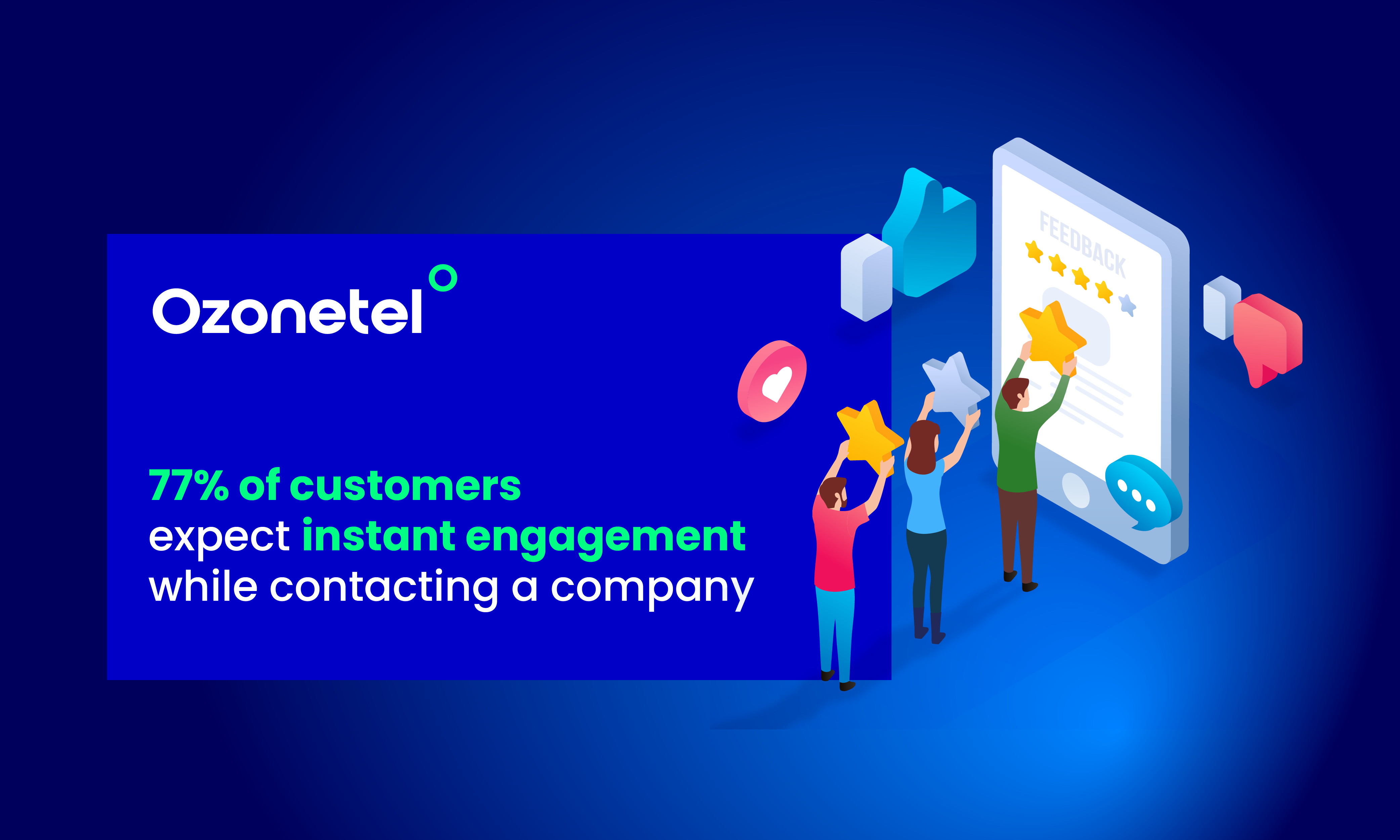- Resources
- A Complete Guide to Digital CX
A Complete Guide to Digital CX

Digital customer experience (CX) refers to customers’ online interactions with your brand. Your clients base their purchasing decisions on your services’ entire experience, including chatbots, social media, your website, and mobile apps.
In fact, 88% of customers believe a company’s experience is as important as its products and services. According to another survey, 79% of consumers under 45 place a high value on having positive digital experiences.
Therefore, investing in a digital CX platform should be a no-brainer. These platforms enable organizations to assess, manage, and improve the digital customer experience by collecting, analyzing, and interpreting data from each customer’s interactions with the firm. There are two types of digital customer experience software platforms: cloud-based and on-premise, each with advantages and disadvantages.
Keep reading as we discuss digital CX, its benefits, and a few best practices you can follow to optimize your business’s digital customer experience.
In this article, we will explore:
What Is Digital Customer Experience (DCX)?
The digital customer experience (DCX) includes all the interactions a customer has with your brand via online channels. These platforms include social media outlets, live chat and email, your website, and mobile apps. The digital experience consists of customers’ perceptions of your brand based on various virtual touchpoints.
Components of Digital CX

Digital CX encompasses various components to deliver a seamless and engaging digital journey.
Let’s understand a few of these components in detail:
Customer Journey Mapping
Customer Journey Mapping involved creating a visual representation of every interaction your customers have with you- from the initial contact to the post-purchase interaction. Customer journey mapping tools helps in understanding how your customers move through the sales funnel and assists in identifying opportunities for improvement.
It’s a strategic approach that allows businesses to understand the path customers take to get to their product or service. It involves identifying key touchpoints, understanding customer needs and emotions at each stage, and pinpointing areas where the customer experience can be improved. .
UI/UX Design
User Interface/User Experience (UI/UX) design is the process of producing user-friendly, visually appealing digital interfaces. Good UI/UX prioritizes clean, clear aesthetics, straightforward navigation, and accessibility, allowing customers to easily identify, compare, and purchase products on your website.
You can accomplish this by designing a minimalist website style with a clear homepage highlighting vital products without clutter. You can accomplish this by teaming up with a web design company that can design a minimalist website style with a clear homepage highlighting vital products without clutter.
Adjustable product filters allow your clients to explore fast, preventing them from feeling lost, distracted, or slowed down.
Real-time Support
AI Chatbots assist brands in providing 24/7 online customer service, ensuring that customer requests are promptly addressed. You eliminate customer friction by making information easily accessible and conducting a purchase or refund.
For live support, the ability to interact within a context and at the right time, in a non-intrusive way that provides value to the recipient. Leveraging AI-based tool for active listening and empathy are also crucial. Leveraging customer data for personalized support, offering multichannel support, and implementing a feedback loop can further improve the digital customer experience.
Customer Feedback & Analytics
Customer feedback provides valuable insights into what customers like or dislike about their experience. This can be collected through various channels like surveys, social media, or direct communication.
Customer experience analytics, on the other hand, plays an important role in helping brands understand and optimize the digital customer experience. It involves collecting, analyzing, and interpreting data from various customer interactions and touchpoints to gain insights into customer behavior, preferences, and pain points. By leveraging analytics, organizations can track customer journey maps, identify bottlenecks or areas of friction, and pinpoint opportunities for improvement.
Analytics also enables customer sentiment analysis, which involves analyzing customer feedback, online reviews, and social media mentions to understand customer sentiment and identify areas that require attention. Predictive analytics, powered by machine learning (ML), can anticipate customer needs, preferences, and potential issues, enabling proactive measures to enhance the customer experience.
Personalization
Customer data may help you better understand your customers and offer more tailored experiences, such as personalized product recommendations. You can accomplish this by deploying AI-powered customization tools that recommend products based on a customer’s previous purchases or browsing behavior. You can also utilize tools such as quizzes to engage clients, collect data, and recommend the best product for them.
Omnichannel Consistency
Omnichannel support is a strategic approach to providing a consistent customer experience across multiple channels or touchpoints. Also, integrating various communication channels, such as websites, mobile apps, social media platforms, email, live chat, and phone support, into a unified and cohesive system. The objective is to make sure that customers can effortlessly transition between different channels while receiving consistent service and personalized interactions.
Omnichannel support aims to eliminate the silos that often exist between different communication channels, enabling customers to pick up where they left off, regardless of the channel they are using. This approach recognizes that customers may switch channels during their journey and expects organizations to provide a seamless and personalized experience.
Security and Privacy
In today’s digital age, data breaches and privacy concerns can significantly impact a brand’s reputation and customer trust. This involves implementing robust security measures such as encryption, two-factor authentication, and secure servers.
Along with security measures, businesses need to comply with data protection regulations and clearly communicate their privacy policies to customers. Transparency about how customer data is used and protected can help build customer trust and nurture customer loyalty.
Why Digital CX Is Important?
Now, a core question arises: Why is digital experience management so important? The answer is obvious: as more businesses relocate to the internet, competition has increased, with clients easily switching between websites.
Let’s dive into the details:
Meeting Customer Expectations
Customers today expect seamless, convenient, and personalized experiences across all digital touchpoints, including websites, mobile apps, social media, and online customer support channels. A superior Digital CX can help businesses meet these expectations and differentiate themselves from competitors.
Enhancing Customer Engagement
Digital channels offer various opportunities for businesses to engage with customers more effectively. Businesses can build stronger customer relationships and foster loyalty through personalized content, targeted marketing campaigns, and real-time interactions.
Improving Operational Efficiency
Digital technologies can streamline processes, automate repetitive tasks, and provide valuable customer data insights. This can improve operational efficiency, reduce costs, and better resource allocation, ultimately enhancing the overall customer experience.
Enabling Data-Driven Decision-making
Digital interactions generate a wealth of customer data, including browsing behavior, purchase patterns, and feedback. By analyzing this data, businesses can get insights into customer preferences and pain points, allowing them to make informed decisions and continuously improve their Digital CX.
Challenges to Seamless Digital CX

Ensuring a seamless digital customer experience (CX) is important for businesses to attract and retain customers in today’s digital landscape. However, organizations often face several challenges in achieving this goal.
Here are some of the key challenges to seamless digital CX:
Lack of Customer Input
In today’s social-driven world, customer decisions are heavily influenced by peer reviews, ratings, and social proof. Yet, many organizations fail to actively solicit, review, or act upon customer input and build customer focused company. To overcome this challenge, businesses must establish systems for collecting customer feedback, such as surveys or feedback forms, and develop processes for implementing customer suggestions.
Additionally, organizations should incentivize customers to provide feedback through rewards or demonstrate a genuine commitment to incorporating their recommendations into future products or services.
Lack of Experimentation and Iteration
Designing an effective customer experience is an iterative process that requires continuous experimentation and refinement based on customer feedback. Many organizations, however, approach CX as a static process, aiming to get it right from the outset. This approach often leads to stalled or incomplete initiatives and a failure to resonate with customers due to a lack of testing and validation.
Instead, businesses should focus on rapidly deploying an initial version, gathering customer feedback, and iterating based on that data until the desired results are achieved. This agile approach allows continuous improvement and ensures that the customer experience evolves to meet changing customer needs and expectations.
Poor CX Design
Effective customer experience design creates a seamless and engaging digital experience. However, many organizations fail to prioritize user experience design, resulting in products or services with unnecessary complexity, confusing navigation, or a lack of intuitive features. Poor CX design can frustrate customers and impede growth and retention.
Organizations must adopt best practices in user experience design and ensure that CX principles are ingrained at an organizational level. This includes conducting usability testing, gathering customer feedback, and refining the design to meet customer expectations.
Organizational Silos
Seamless digital CX requires a consistent and integrated experience across all customer touchpoints. However, many organizations operate in silos, with different departments or channels functioning independently, leading to disjointed and fragmented customer experiences.
To overcome this challenge, organizations must break down these silos and adopt a holistic approach where customer data is visible and accessible across the entire organization. By integrating data and processes, businesses can gain a complete view of the customer journey, enabling seamless transitions between channels and improving overall customer satisfaction.
Lack of Personalization
Implementing personalization strategies requires a comprehensive understanding of customer journey mapping and the integration of technologies such as artificial intelligence and machine learning. These technologies enable real-time decision-making and automation, allowing businesses to deliver personalized experiences at scale without compromising efficiency.
One of the key challenges remains leveraging the customer data effectively, segmenting their audience, predicting preferences, and delivering highly targeted and relevant experiences across various touchpoints.
Insufficient Understanding of Customer Journey
While customer journey mapping is useful for understanding the customer experience, it is not enough. Many organizations need to leverage customer data to bring these journey maps to life. Without integrating real-time customer data, journey maps become static representations that do not accurately reflect the dynamic nature of customer interactions.
Organizations must employ analytical tools powered by artificial intelligence (AI) and machine learning (ML) to analyze customer behavior across various digital channels. This analysis can help identify friction points and improvement areas, enabling real-time predictions and responses to customer behavior, ultimately leading to a more seamless experience.
Digital CX: Best Practices to Follow
Think of digital CX as the online extension of your company’s CX strategy. It refers to the digital channels via which your customers interact with those individuals and things. And the perceptions people form as a result of their experiences.
Now that we’ve introduced you to the notion, let’s review some best practices for optimizing digital CX in your firm.
Know Your Audience
Knowing your audience intimately is the foundation for creating a successful digital customer experience. This involves developing rich buyer personas based on extensive customer data and research to deeply understand their demographics, behaviors, goals, and pain points. It’s crucial to map the entire customer journey from initial awareness to purchase and retention, identifying all the key touch points.
Collect and synthesize data from lead forms, website interactions, purchase history, and more to build comprehensive, unified customer profiles. Then, continuously update and refine these profiles as you gather more insights.
Create an Omnichannel+ Experience
Creating an omnichannel+ experience is critical for providing a seamless, consistent experience regardless of which digital channel customers interact with your brand. This means ensuring unified brand messaging, visual design, and overall experience quality across your website, mobile app, social media platforms, email campaigns, messaging channels, and more.
Leverage technology to enable seamless data integration and syncing of customer information across touchpoints. Empower customers to pick up wherever they left off and switch between channels frictionlessly without repeating information. Tools like customer data platforms can help create this unified customer view.
Focus on Mobile
With over 90% of internet traffic coming from mobile devices, optimizing digital experiences for mobile is imperative. This means designing websites and applications to be fully responsive on smaller mobile screens. Pay close attention to optimizing for mobile-specific factors like speed, simplicity, and ease of use. Integrate mobile-friendly features like click-to-call, geo-location, and camera capabilities. And leverage capabilities like push notifications to enable timely, contextual engagement based on a user’s real-time mobile usage.
Adopt Analytics
To properly understand how customers are experiencing your digital properties and identify areas for improvement, it’s essential to adopt advanced analytics tools. Implement comprehensive web analytics, mobile app analytics, marketing attribution, and more to track metrics like traffic sources, user journeys, conversion rates, drop-off points, feature usage patterns, and more. Leverage AI and machine learning capabilities to uncover deep behavioral patterns and predictive insights. A/B test variations to optimize user flows and content and offers for better engagement.
Collect Customer Feedback
While analyzing data provides quantitative insights, collecting qualitative customer feedback is equally important. Gather feedback via Net Promoter Score surveys, ratings and reviews, and social media listening. This helps clue you into delight and friction in the customer journey. Continuously incorporate this voice of customer feedback to improve your products and experiences iteratively. And be sure to close the loop by promptly responding to and addressing customer concerns.
Conduct User Testing
Another powerful technique is to conduct user testing and research. This allows you to test aspects like usability, information architecture, task flows, and more with a sample user group before rolling out experiences widely. Leverage user testing tools to record sessions, capture heatmaps, gather surveys, and provide detailed insights into how users experience your digital properties. Then, use these findings to iteratively optimize and refine the experience to be as seamless and intuitive as possible across different devices, platforms, and user scenarios.
Have a Futurist Mindset
It’s critical to think with a futurist mindset and be updated on new technologies that can transform digital experiences – such as AI, chatbots, AR/VR, voice interfaces, and more. Continuously assess how new technological capabilities can be leveraged to enhance convenience, personalization, engagement, and overall customer value.
Adopt an experimentation mindset to constantly pilot innovative new digital experiences that capitalize on these emerging capabilities. And foster a business culture of continuous learning and adaptability to stay ahead of technological disruption.
Benefits of Using the Digital CX Platform
A digital CX platform helps organizations create a centralized repository for customer data, breaking down information silos across different departments and systems. This ‘single source of truth’ ensures that every team can access accurate, up-to-date customer information, enabling them to deliver consistent and relevant experiences across all customer journey touchpoints.
Here are a few more key benefits of using a digital customer experience (CX) platform:
Dynamic Customer Profiles
By consolidating customer data from multiple sources, a digital CX platform allows organizations to build dynamic customer profiles that evolve as customers interact with the brand. These profiles capture customers’ preferences, behaviors, and purchase histories, enabling businesses to anticipate their needs and deliver personalized experiences that resonate with them at every stage of their journey.
Personalization at Scale
By leveraging advanced technologies like artificial intelligence and machine learning, digital CX platforms can process massive amounts of customer data to generate valuable insights. This capability enables organizations to achieve personalization at scale, tailoring interactions and content for large segments or individual customers, resulting in improved customer satisfaction, loyalty, and increased sales.
Seamless Customer Experience
Digital CX platforms integrate with various enterprise systems, such as content management, enterprise resource planning (ERP), and customer relationship management (CRM) ensuring a streamlined customer experience across all touchpoints and throughout the entire customer lifecycle, right from the initial awareness to post-purchase support and customer retention.
Improved Data Governance and Compliance
With stringent data privacy regulations like GDPR and CCPA, organizations must exercise caution when handling customer data. Digital CX platforms provide a centralized location for customer data, allowing businesses to apply consistent governance policies and ensure compliance with data protection laws, minimizing the risk of potential violations and associated penalties.
How Ozonetel Digital CX Platform Transforms Customer Experience
Ozonetel offers a comprehensive digital Customer Experience (CX) platform designed to deliver superior experiences across digital touchpoints throughout the customer journey. This platform accelerates business growth by leveraging key capabilities such as omnichannel routing, customer data and insights, automation through chatbots, agent assist features, and integrated analytics around interactions.
Ensure Seamless Digital Journeys
Ozonetel’s Customer Journey Studio is a user-friendly, drag-and-drop tool that allows you to design customer journeys tailored to their specific needs. Embedded with Artificial Intelligence (AI) and Natural Language Processing (NLP) capabilities, it enables intelligent and natural interactions with customers. With our AI insights & low code tools, you can discover the most opportune moments to engage customers, whether it’s to foster referrals, drive sales, or enhance overall satisfaction, all in real-time.
Hyper-personalize Campaigns at Scale
Ozonetel’s conversational marketing solutions enable businesses to expand their customer reach and reduce the cost per acquisition through innovative campaigns. With seamless cross-channel scheduling, businesses can amplify their reach across various digital platforms. By engaging customers at opportune moments on their preferred messaging channels, brands can foster meaningful interactions. Businesses have leveraged our AI-based solutions to hyper-personalize messages at scale, driving conversations and enhancing overall engagement.
Empower Field Teams to Respond Anytime, Anywhere
This tool empowers your field staff to promptly respond to prospects or customers via WhatsApp directly from their mobile devices, regardless of location and time. This real-time enterprise communication capability ensures exceptional customer service and efficiency in converting prospects into customers.
With this feature, agents can securely respond to queries from their mobile phones, ensuring that customer interactions are handled with care and confidentiality. The WhatsApp Switchboard provides AI-driven insights from chat transcripts, enabling you to continually improve interactions and enhance the overall customer experience.
Close Deals & Resolve Queries in a Single Interaction
Leverage Ozonetel’s integrated Chat and Call functionality to redefine omnichannel excellence. Our industry-first feature empowers agents to effortlessly manage WhatsApp messages while actively engaged in a call, ensuring uninterrupted customer support.
Using this feature, you can boost first call resolutions by seamlessly addressing customer issues within a single call. This will help you guide leads and facilitate quick document exchange to ensure swift sale closures, optimizing sales performance. By reducing the workload on sales and service teams, our solution drives increased productivity and profitability for your business.
Leverage Insights Extracted From Millions of Digital Conversations
Businesses can leverage Ozonetel GenAI-powered solutions to extract valuable insights from vast volumes of digital conversations. By providing real-time context to agents, it enhances engagement and facilitates quicker issue resolution.
Our AI solutions help businesses fine-tune sales pitches and adept handling of objections, thereby driving higher conversions. Additionally, it empowers businesses to uncover the underlying causes of dissatisfaction through ‘Voice of the Customer’ insights.
Continuous monitoring of interactions allows for the identification of specific areas for improvement and enables customized agent training initiatives.
Enable Seamless AI-led Digital Interactions
Our chatbot platform is easy to use and doesn’t require any coding. It comes with ready-made templates for different situations and industries. You can pick the one that suits you best. At the core of the Ozonetel bot designer lies its ability to understand user intent and initiate conversations effectively. The digital bot designer uses advanced AI algorithms to understand and respond to customer queries, improving efficiency and customer satisfaction. The bot can be trained and improved over time, ensuring it stays relevant and effective.
Conclusion
Providing a consistent experience across all channels helps improve the customer’s digital journey, resulting in better UX. Furthermore, a pleasant digital experience can generate positive online reviews and social media shares, increasing your company’s online presence and reputation. A poor digital experience, on the other hand, might lead to negative feedback and harm your brand’s image.
As a result, it is critical to provide your consumers with an optimal digital CX experience that covers all digital touchpoints they encounter with your company, such as your website, mobile experience, social media platforms, emails, and online customer care.
Want to see what Ozonetel can do for your company? Sign up today for a free 7-day trial.
Prashanth Kancherla
Chief Operating Officer, Ozonetel Communications
Over the past decade, Prashanth has worked with 3000+ customer experience and contact center leaders...
Chief Operating Officer, Ozonetel Communications
Over the past decade, Prashanth has worked with 3000+ customer experience and contact center leaders to comprehensively understand the need for effective and efficient customer communications at every step of their journey with a brand. Deeply embedded in today’s CCaaS ecosystem, he has been instrumental in Ozonetel's growth and contributed in various roles including product management, sales, and solution architecture.
Frequently Asked Questions
Customer Experience (CX) in digital means how people interact with a brand online. It includes using websites, apps, and social media. Good digital CX makes it easy for customers to find what they need and enjoy their time online. A seamless and positive digital CX ensures that customers can easily find information, make purchases, resolve issues, and engage with the brand across various online platforms. It plays a vital role in shaping customers’ perceptions of the brand and influences their overall satisfaction and loyalty.
Digital first CX means when a company focuses on digital channels, like websites and apps, for customer interactions. At a time when consumers are heavily reliant on online platforms for information and transactions, providing digital-first CX has become a necessity. By prioritizing digital delivery over traditional print channels, businesses can adapt quickly and meet the evolving preferences and expectations of their digitally savvy customers.
A digital CX manager has expertise in optimizing a business’s online platforms to boost traffic, usability, and the overall customer experience. They oversee all digital touchpoints throughout the customer journey, including website design, mobile app functionality, social media interactions, and online customer service. Digital CX managers analyze customer behavior and feedback to identify areas for improvement and implement strategies to enhance the user experience.
Digital CX is important because it affects how happy customers are and whether they stay loyal to a brand. Customers expect seamless and convenient experiences across all digital touchpoints, and failing to meet these expectations can result in dissatisfaction and churn. Positive digital CX, on the other hand, not only enhances customer interactions but also strengthens brand perception and loyalty.







